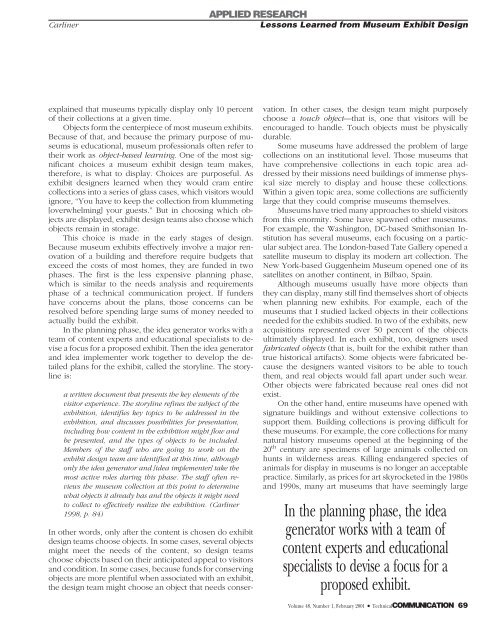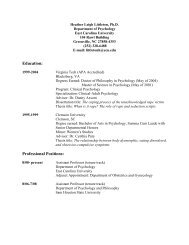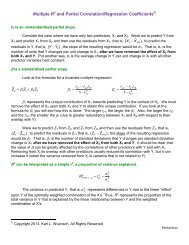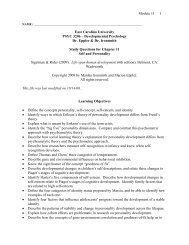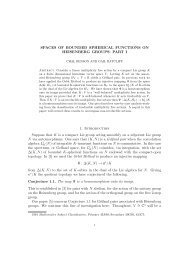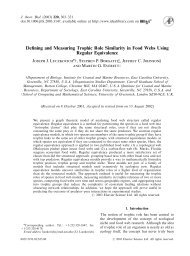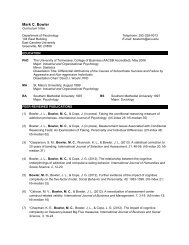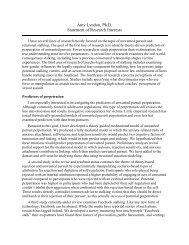Modeling Information for Three-Dimensional Space - Ecu
Modeling Information for Three-Dimensional Space - Ecu
Modeling Information for Three-Dimensional Space - Ecu
Create successful ePaper yourself
Turn your PDF publications into a flip-book with our unique Google optimized e-Paper software.
Carliner<br />
APPLIED RESEARCH<br />
Lessons Learned from Museum Exhibit Design<br />
explained that museums typically display only 10 percent<br />
of their collections at a given time.<br />
Objects <strong>for</strong>m the centerpiece of most museum exhibits.<br />
Because of that, and because the primary purpose of museums<br />
is educational, museum professionals often refer to<br />
their work as object-based learning. One of the most significant<br />
choices a museum exhibit design team makes,<br />
there<strong>for</strong>e, is what to display. Choices are purposeful. As<br />
exhibit designers learned when they would cram entire<br />
collections into a series of glass cases, which visitors would<br />
ignore, “You have to keep the collection from klummeting<br />
[overwhelming] your guests.” But in choosing which objects<br />
are displayed, exhibit design teams also choose which<br />
objects remain in storage.<br />
This choice is made in the early stages of design.<br />
Because museum exhibits effectively involve a major renovation<br />
of a building and there<strong>for</strong>e require budgets that<br />
exceed the costs of most homes, they are funded in two<br />
phases. The first is the less expensive planning phase,<br />
which is similar to the needs analysis and requirements<br />
phase of a technical communication project. If funders<br />
have concerns about the plans, those concerns can be<br />
resolved be<strong>for</strong>e spending large sums of money needed to<br />
actually build the exhibit.<br />
In the planning phase, the idea generator works with a<br />
team of content experts and educational specialists to devise<br />
a focus <strong>for</strong> a proposed exhibit. Then the idea generator<br />
and idea implementer work together to develop the detailed<br />
plans <strong>for</strong> the exhibit, called the storyline. The storyline<br />
is:<br />
a written document that presents the key elements of the<br />
visitor experience. The storyline refines the subject of the<br />
exhibition, identifies key topics to be addressed in the<br />
exhibition, and discusses possibilities <strong>for</strong> presentation,<br />
including how content in the exhibition might flow and<br />
be presented, and the types of objects to be included.<br />
Members of the staff who are going to work on the<br />
exhibit design team are identified at this time, although<br />
only the idea generator and [idea implementer] take the<br />
most active roles during this phase. The staff often reviews<br />
the museum collection at this point to determine<br />
what objects it already has and the objects it might need<br />
to collect to effectively realize the exhibition. (Carliner<br />
1998, p. 84)<br />
In other words, only after the content is chosen do exhibit<br />
design teams choose objects. In some cases, several objects<br />
might meet the needs of the content, so design teams<br />
choose objects based on their anticipated appeal to visitors<br />
and condition. In some cases, because funds <strong>for</strong> conserving<br />
objects are more plentiful when associated with an exhibit,<br />
the design team might choose an object that needs conservation.<br />
In other cases, the design team might purposely<br />
choose a touch object—that is, one that visitors will be<br />
encouraged to handle. Touch objects must be physically<br />
durable.<br />
Some museums have addressed the problem of large<br />
collections on an institutional level. Those museums that<br />
have comprehensive collections in each topic area addressed<br />
by their missions need buildings of immense physical<br />
size merely to display and house these collections.<br />
Within a given topic area, some collections are sufficiently<br />
large that they could comprise museums themselves.<br />
Museums have tried many approaches to shield visitors<br />
from this enormity. Some have spawned other museums.<br />
For example, the Washington, DC-based Smithsonian Institution<br />
has several museums, each focusing on a particular<br />
subject area. The London-based Tate Gallery opened a<br />
satellite museum to display its modern art collection. The<br />
New York-based Guggenheim Museum opened one of its<br />
satellites on another continent, in Bilbao, Spain.<br />
Although museums usually have more objects than<br />
they can display, many still find themselves short of objects<br />
when planning new exhibits. For example, each of the<br />
museums that I studied lacked objects in their collections<br />
needed <strong>for</strong> the exhibits studied. In two of the exhibits, new<br />
acquisitions represented over 50 percent of the objects<br />
ultimately displayed. In each exhibit, too, designers used<br />
fabricated objects (that is, built <strong>for</strong> the exhibit rather than<br />
true historical artifacts). Some objects were fabricated because<br />
the designers wanted visitors to be able to touch<br />
them, and real objects would fall apart under such wear.<br />
Other objects were fabricated because real ones did not<br />
exist.<br />
On the other hand, entire museums have opened with<br />
signature buildings and without extensive collections to<br />
support them. Building collections is proving difficult <strong>for</strong><br />
these museums. For example, the core collections <strong>for</strong> many<br />
natural history museums opened at the beginning of the<br />
20 th century are specimens of large animals collected on<br />
hunts in wilderness areas. Killing endangered species of<br />
animals <strong>for</strong> display in museums is no longer an acceptable<br />
practice. Similarly, as prices <strong>for</strong> art skyrocketed in the 1980s<br />
and 1990s, many art museums that have seemingly large<br />
In the planning phase, the idea<br />
generator works with a team of<br />
content experts and educational<br />
specialists to devise a focus <strong>for</strong> a<br />
proposed exhibit.<br />
Volume 48, Number 1, February 2001 • TechnicalCOMMUNICATION 69


